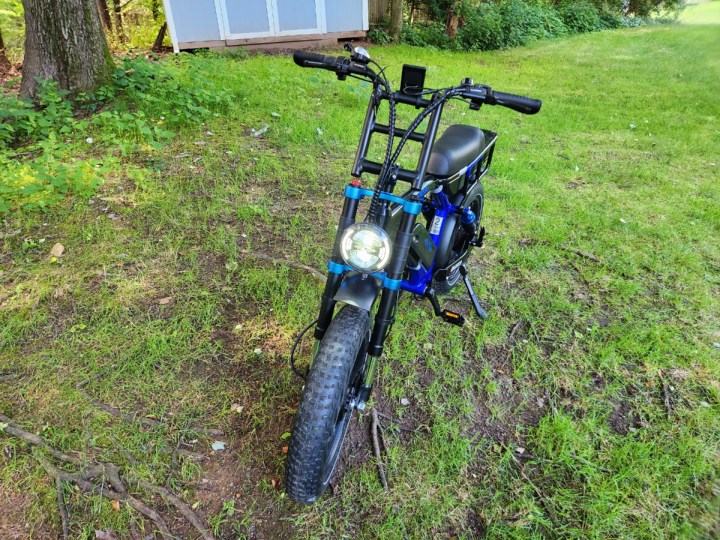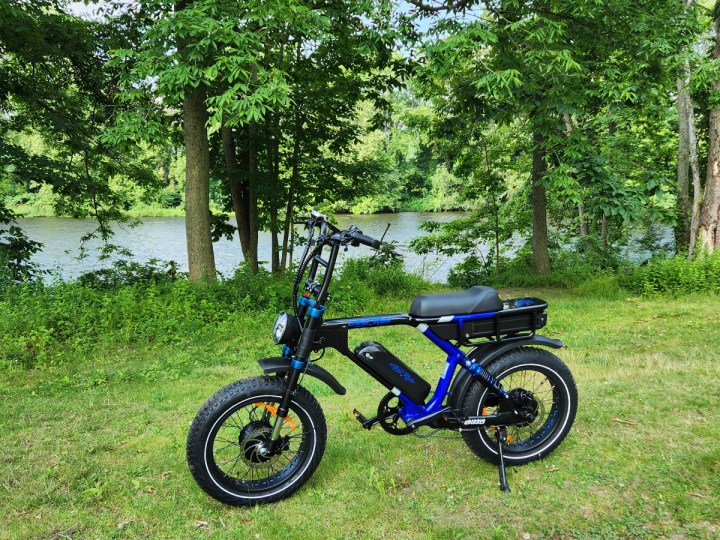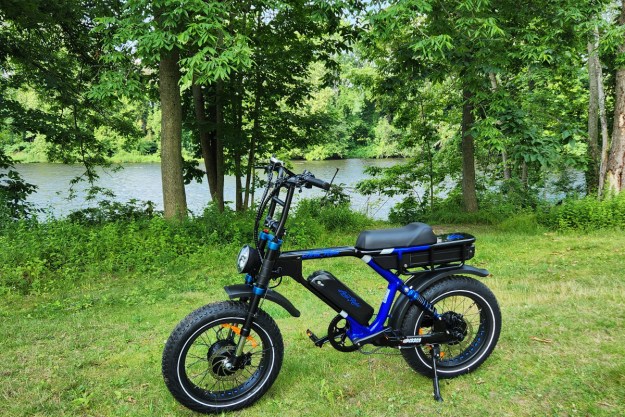
- Crazy-fast acceleration, top speed
- Dual batteries for longer trips
- Full suspension smooths the ride
- No-compromise components
- Street and off-road versatility
- Relatively high cost
- Instant power requires vigilance
- One charger for two batteries
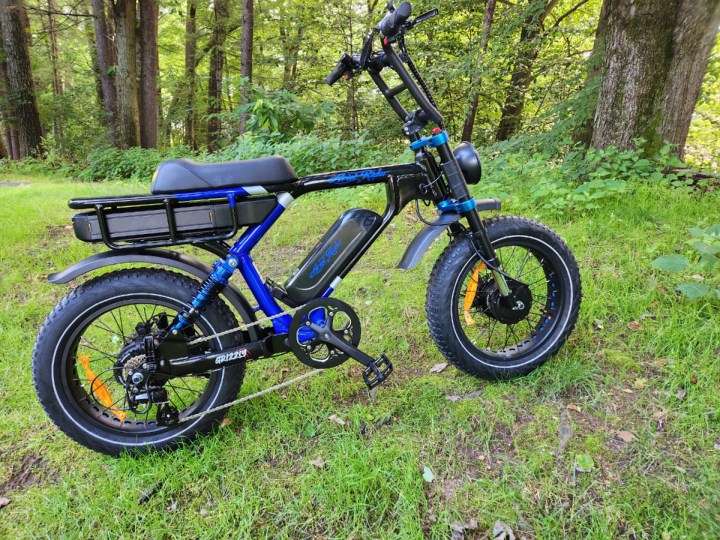
The Rule of Twos explains the success of the powerful Ariel Rider X-Class 52V Grizzly e-bike. The moped-style e-bike has high-powered motors on each wheel, dual batteries, dual suspension systems, and front and rear hydraulic disc brakes. Even with just one motor and one battery, the Grizzly would be a formidable, speedy ride, but with both batteries turned on and both motors activated, you’d better be sure you’re seated and ready to go before you twist the throttle.
The Ariel Grizzly frankly isn’t a great choice for everyone, especially beginners or riders who want convenient e-bike transportation, but don’t care about going faster than 20 miles per hour. As I mentioned in the recent Rad Power Bikes RadRunner 3 Plus review, fast acceleration and high speeds aren’t the priority in e-bikes designed for versatility, where the goal is carrying young passengers or commuting.
However, the Ariel X Class 52V Grizzly’s primary purpose is high performance. Ariel Rider categorizes the Grizzly as a scrambler e-bike built for on- and off-road adventures. The result is an e-bike that focuses on seriously fast fun.
The go-fast parts: dual by design
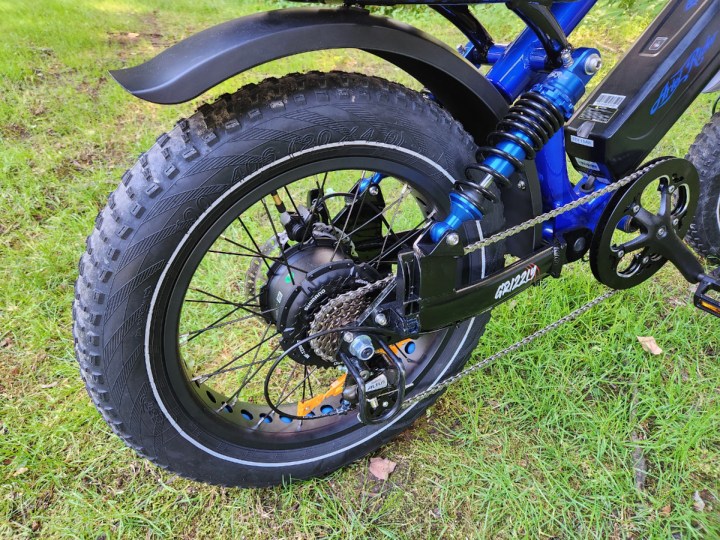
Ariel hits the Grizzly’s design goal by doubling up on the good stuff. Rather than settling for one Bafang 52-volt electric geared hub motor, the Grizzly has two, one on each wheel. Each motor is rated for 1,000 watts continuous power and 1,850W peak power. Compare that to the 500W continuous and 750W motors on many common e-bikes, and the Grizzly’s power boost is clear. A red rocker switch on the left side of the handlebar selects the front motor only, rear motor only, or both.
I tested the Grizzly with both front and rear motors activated because that’s how most buyers will use it. Manufacturers usually mount hub-drive e-bike motors on the back wheel. With the Grizzly’s two motors activated, both grab hard for traction when you twist the throttle. It can be a new experience if you’re accustomed to e-bikes with mid-drive-only or rear hub-only electric motors. You can’t avoid learning to respect the Grizzly’s power because there’s no subtlety about its instant torque delivery. My best advice is to be cautious, as always, but especially when you take the Grizzly for your first rides.
The Grizzly also has two lithium-ion batteries. A 52V 20-Ah battery mounts on the V-frame and a 52V 15-Ah battery installs under the seat. So that’s a combined total of 1,820 watt hours at your disposal when you start riding with both batteries fully charged. Ariel claims up to 75 miles range, but as always with e-bikes, your mileage per charge will vary depending on a myriad of factors, including how much you pedal the bike, how much you weigh, and even how smooth the road is.
You can charge both batteries on the bike, or remove them to charge in your house or garage. The first version of the Grizzly came with two battery chargers, but this edition includes one 52V 5A output charger. Each battery has an on-off power switch and a battery charge level indicator. Depending on your usage preference or range anxiety level, you may want to use the larger V-frame-mounted battery first and the under-seat battery as a secondary backup battery to get you home.
The Grizzly also has two adjustable suspension systems to suit different riding styles and rider weights. A rotating knob on the top side of the front suspension fork adjusts the compression level to control fork travel. The rear suspension uses motorcycle-like air shock absorbers that adjust with an optional shock pump.
To tame the Grizzly’s immense power, Ariel equips it with front and rear Tektro hydraulic disc brakes with substantial 180mm brake rotors. Hydraulic disc brakes deliver smoother stops, with less brake lever pressure than the more common mechanical brakes.
With all that power, is it ridable?
Besides sheer speed, the third-generation Grizzly benefits from a number of creature comforts that have been added over the years. For instance, a red button on the right handlebar lets you safely disarm the throttle with a flick of the thumb, just like a motorcycle. Very few e-bikes include this feature, but when you’re moving it around in the garage with the power turned on, you’ll definitely want to avoid waking this beast up by accident. It’s also nice to deactivate the throttle when you want a serene pedal-powered cruise, rather than a ride on a rocket ship.
When I grabbed the throttle to get around a parked car, the display read 39.1 mph, the fastest I’ve ridden on an e-bike.
The Grizzly’s raised handlebars and grips allow for an ergonomic, upright riding posture, which makes it easier to see the road surface just ahead of the front wheel, as well as other traffic. You can always tuck in to lower wind resistance at higher speeds, but with the power of this bike, you don’t really need to.
The standard Grizzly seat fits one person, but a set of fold-up foot pegs for a rear passenger are installed as standard equipment on the Grizzly, ostensibly for use when you buy an optional rear passenger seat. In a bind, you could brave it sitting on the metal rack, but I wouldn’t recommend it.
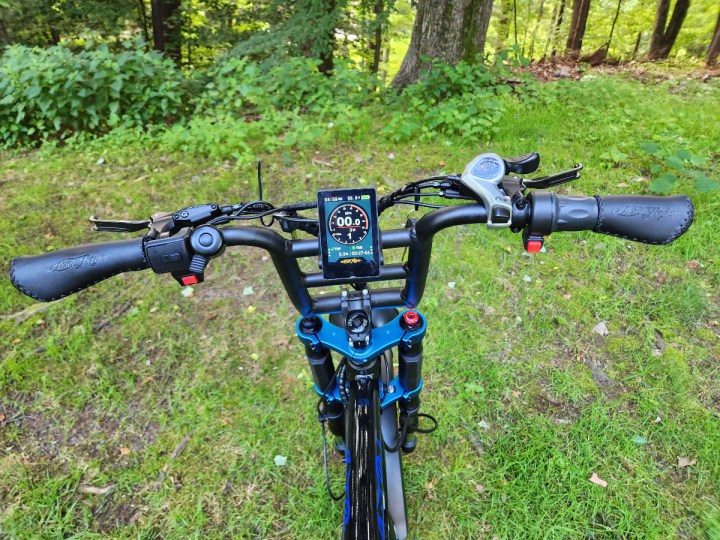
A colorful, center-mounted LED display with bright backlighting indicates pedal assist mode, current speed, maximum speed, trip distance, overall mileage, and the time. Plus and minus buttons let you switch between five pedal assist modes. Level zero turns off pedal power assistance completely, leaving you with a very tough bike to pedal very far. Another button turns the powerful LED headlight on or off — the default is on.
Hang on and hold tight

Despite all the focus on speed, the Grizzly comes out of the box classified as a Class 2 e-bike. That means it ships with a 20 mph speed limit, which is required for legal use on public roads in many states. But digging into the system settings menu unlocks a wealth of other options. You can reprogram the speed limit to 28 mph if you want to set it up for the Class 3 standard, or totally unlimited if you plan to ride on private property. For testing purposes, I reconfigured the Grizzly’s settings for unlimited mode because I knew I’d be riding off-road during at least part of the testing.
I learned what unlimited means on the Grizzly during a shakedown ride after assembly, when I grabbed a bit of throttle to get around a parked car. To my surprise, when I glanced at the display, it indicated 39.1 mph, the fastest I’ve ridden on a legit e-bike. That also turned out to be the fastest indicated speed on flat ground during my testing.
At these speeds, you really come to appreciate the bike’s rugged build quality and name-brand components. I felt full confidence in its ability to travel consistently and safely at these speeds, but other than a few test sprints, I reserved my higher-speed testing for private roadways.
You totally should buy the Ariel Rider Grizzly if you are an experienced rider who craves high performance.
With both batteries and motors clicked on, I found I needed to be aware of the front end wanting to rise up every time I started off in throttle mode. I weigh about 155 pounds, a bit more than half the Grizzly’s 300-pound capacity. With a little practice, I was able to feather the throttle and twist it with light pressure, to keep the power under control.
With the Grizzly’s front fork suspension adjusted to the softest setting, ride quality was one of my favorite features of the bike. Whether riding on smooth pavement, a private road with crumbling asphalt, wet grassy hills, or moderate off-road terrain, it soaked up bumps with aplomb.
Despite typically preferring a throttle, I came to appreciate the Grizzly’s pedal-assist mode when I wanted to noodle around the neighborhood. Set to level one, pedal assist tops out at about 22 mph, a reasonable speed that the Grizzly reaches quickly without the race car performance rush of twisting the throttle.
Our take
You totally should buy the Ariel Rider Grizzly if you are an experienced e-bike or motorcycle rider who craves high performance. The $3,300 price tag is a fair piece of change, but you won’t likely need to spend more for upgrades unless you want to add a passenger seat.
The Grizzly costs a bit less than the $3,595 Super73-S Adventure Series scrambler, which has front fork suspension, but no rear suspension, and $700 less than the full-suspension Super73-R Adventure Series moped-style e-bike that originally defined the category. If you like the Grizzly, but don’t want to lay out more than three grand for an e-bike, you might want to consider Ariel’s X-Class 52V e-bike. It sells for just $2,200 with a single 1,000W geared hub motor, one 20-Ah 52V battery, and adjustable front and rear suspension.
The unleashed Grizzly is an outstanding performance e-bike, but as I learned in testing, it can also act like a laid-back Class 2 cruiser, so it’s almost like getting two e-bikes for the price of one.



